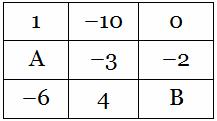Numbers Worksheet-2
q: when two negative integers are added, we get a positive integer, then
(a) Both p and q are true (b) p is true and q is false
(c) p is false and q is true (d) Both p and q are false

(a) –7, –4 (b) –4, –7 (c) –4, –6 (d) –6, –4
(a) 0 (b) 1 (c) 2 (d) 3
q : (a ÷ b) ÷ c ≠ a ÷ (6 + c), then
(a) Both p and g are true (b) p is true and q is false
(c) p is false and q is true (d) Both p and q are false
(a) 20 seconds (b) 39 seconds (c) 40 seconds (d) 30 seconds
(a) 410 litres (b) 491 litres (c) 400 litres (d) 90 litres
q : (–8) + 0 = not defined, then
(a) Both p and q are true (b) p is true and q is false
(c) p is false and q is true (d) Both p and q are false
(a) –1 (b) 1 (c) 0 (d) 2
(a) –20 (b) –19 (c) –22 (d) –21
(a) –1 (b) –2 (c) –3 (d) –4
(a) 37 (b) 19 (c) –120 (d) –93
(a) > (b) < (c) ≥ (d) ≤
(a) Both p and q are true (b) p is true and q is false
(c) p is false and q is true (d) Both p and q are false
(a) 10 (b) 20 (c) 30 (d) 40
(a) – 4 (b) –5 (c) 0 (d) –8
(a) All natural numbers are whole numbers, all whole numbers are integers
(b) All whole numbers are integers, all integers are natural numbers
(c) All integers are whole numbers, all natural numbers are integers
(d) All integers are whole numbers, all integers are natural numbers
(a) 300 (b) 30 (c) 21 (d) 3
(a) 13 (b) 14 (c) 15 (d) 16
(a) –1 (b) 1 (c) –1 or 1 (d) 2
–19 × (4 + (–2)) = –19 × 4 + (–19) × x, is
(a) 2 (b) –19 (c) 4 (d) –2
Answer Key:
(1)-(d); (2)-(c); (3)-(b); (4)-(c); (5)-(b); (6)-(a); (7)-(a); (8)-(c); (9)-(d); (10)-(d); (11)-(b); (12)-(b); (13)-(b); (14)-(c); (15)-(d); (16)-(a); (17)-(b); (18)-(c); (19)-(b); (20)-(d)